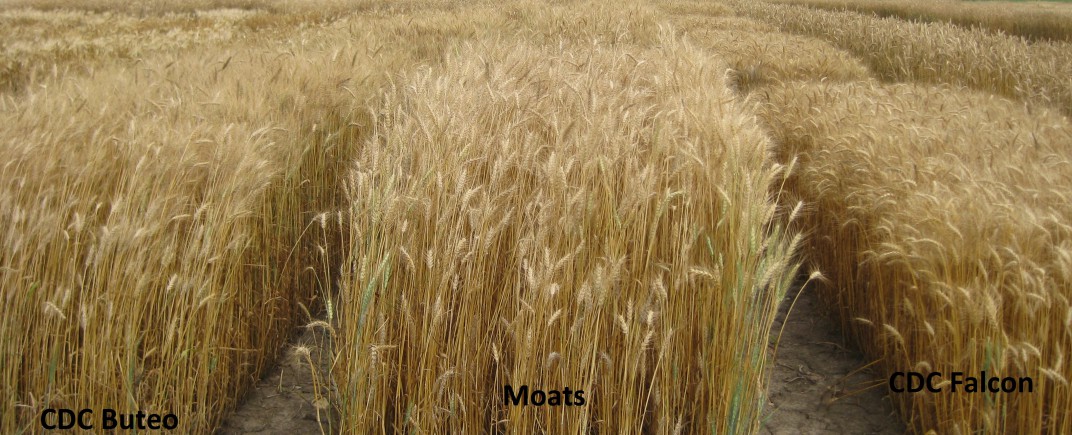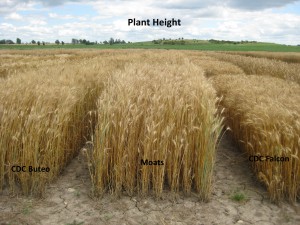Winter wheat (Triticum aestivum) – Profile by Joshua Moats
Winter wheat (Triticum aestivum) is a winter annual version of typical bread wheat that is grown on the Canadian prairies. Depending on the variety, it can have several end uses, some of which are bread and animal feed (Fowler 1995).
Winter wheat is an important crop because it varies crop rotations while incorporating easily into existing systems, and maintaining high quality and reasonable prices.
Identification
Winter wheat looks similar to the traditional spring wheat grown on the Canadian prairies. It is a determinate grassy plant that has a vegetative phase followed by a reproductive phase. It is generally distinguishable from spring wheat by its earlier maturity and usually beardless heads.
Adaptation
Wheat originated in the fertile crescent as winter wheat, where it vernalized in the rainy season and produced in spring before the dry season brought it to physical maturity.
In Western Canada and Russia, it has been bred for cold tolerance. Even so, it generally requires at least eight centimeters of unpacked snow, and a higher seeding rate than its summer annual counterpart to produce a healthy stand in harsh winters (Fowler 1995) (Sask Ag. 2008). Winter wheat is a more popular choice in the milder climates of Eastern Canada, the United States and Europe where longer, milder growing seasons make it a safer option.
In Western Canada, it is often seeded in rotation with a pulse and oilseed to control weeds with an annual lifestyle and relieve spring seeding timing pressures. In the United States, it is commonly seeded in rotation with corn and soybeans. In organic agriculture, winter wheat is also grown as a companion crop undersown with a legume to increase protein content and the overall grade of the crop. This can be done with alfalfa (Medicago sativa), black medick (Medicago lupulina), red clover (Trifolium pratense), white clover (Trifolium repens), or Australian winter peas (Pisum sativum) (Blackshaw 2010) (Amosse 2013).
Cropping Considerations
Winter wheat is a valued addition to primarily annual crop rotations, because it effectively controls most annual weeds through strong early season competition. This competitive effect is very dependent on the crop density, and therefore the seeding rate of the crop. To secure a competitive crop stand, seeding rates have to be increased, because the overwintering process inevitably results in some winter kill. If this winter kill is accommodated, then crop densities of 125 to 270 plants m-2 result in sufficient grain yield and significant weed suppression (Korres 2004).
Seeding a winter annual in a primarily summer annual dominated crop rotation tends to shift weed populations, and can benefit overall weed control. In organic systems, delayed seeding and spring tillage are often used as a mechanical control method. In the case of winter wheat, this early season till would be removed, and early season competition from the winter wheat, which was already established in the previous fall controls annual weeds. Gradually, the proportion of winter annual weeds will increase in cropping systems utilizing this tactic (Helmut 2010).
Unfortunately, weed control in the fall before the seeding of winter wheat is problematic, because physical weed control knocks down stubble which is very valuable in winter wheat production. The stubble is required for a snow trap to insulate the wheat over the winter, and tillage destroys this stubble cover. Winter wheat is ideally seeded after oilseed rape in Western Canada, because it combines relatively early maturity with long stubble lengths for snow trapping. Seeding into barley or oat stubble is also a possibility, but may be a nutritional problem for the plant. Seeding into pulse stubble is ineffective due to low volume and snow trapping capability (Fowler 1995) (Sask Ag. 2008).
Genetics are an important part of any agricultural system. While not much attention has gone to organic breeding in Western Canada, in Europe, there is an effort to isolate qualities under organic conditions, rather than just conventional ones. This is called Bred for Organic Agriculture (BFOA). This idea could develop into a whole new set of market classes for Western Canadian wheat and winter wheat eventually (Loschenberger 2008).
Summary
Winter wheat is an important cereal crop across the world. It is sown in Western Canada, but relies on snow cover to insulate it from harsh winters. This has caused the bulk of winter wheat breeding to be focused on winter hardiness and yield (to compete with spring wheat varieties). The snow trapping requirement has agronomic implications, limiting possible rotations and weed control in the spring and fall. However, early season competition can serve to break up summer annual dominated rotations. More breeding effort may be focused into varieties intended for organic production soon.
References
Amosse, C., M.H. Jeuffroy, and C. David. 2013. Relay intercropping of legume cover crops in organic winter wheat: Effects on performance and resource availability. Field Crops Research 145: 78-87. DOI: http://dx.doi.org/10.1016/j.fcr.2013.02.010
Blackshaw, R.E., L.J. Molnar, and J.R. Moyer. 2010. Suitability of legume cover crop-winter wheat intercrops on the semi-arid Canadian prairies. Can. J. Plant Sci. 90:479-488.
Fowler, D.B., and L.R. Moats. 1995. Winter Wheat Production Manual. University of Saskatchewan. URL:http://www.usask.ca/agriculture/plantsci/winter_cereals/index.php
Helmut, M., S. Mediene, R. Waldhardt, J. Caneill and N. Munier. 2010. Contrasting weed species composition in perennial alfalfas and six annual crops: implications for integrated weed management. Agronomy for Sustainable Development 30:3657-666. DOI: 10.1051/agro/2009043
Korres, N.E. and R. J. Froud-Williams. 2004. The interrelationships of winter wheat cultivars, crop density and competition of naturally occurring weed flora. Biological Agriculture and Horticulture 22:1 1-20. DOI: 10.1080/01448765.2004.9754984
Loschenberger, F., A. Fleck, H. Grausgruber, H. Hetzendorfer, G. Hof, J. Lafferty, M. Marn, A. Neumayer, G. Pfaffinger and J. Birschitzky. 2008. Breeding for organic agriculture: the example of winter wheat in Austria. Euphytica 163:469–480. DOI: 10.1007/s10681-008-9709-2 Sask Ag. 2008. Winter Wheat FAQ. Government of Saskatchewan. URL: http://www.agriculture.gov.sk.ca/winter-wheat


